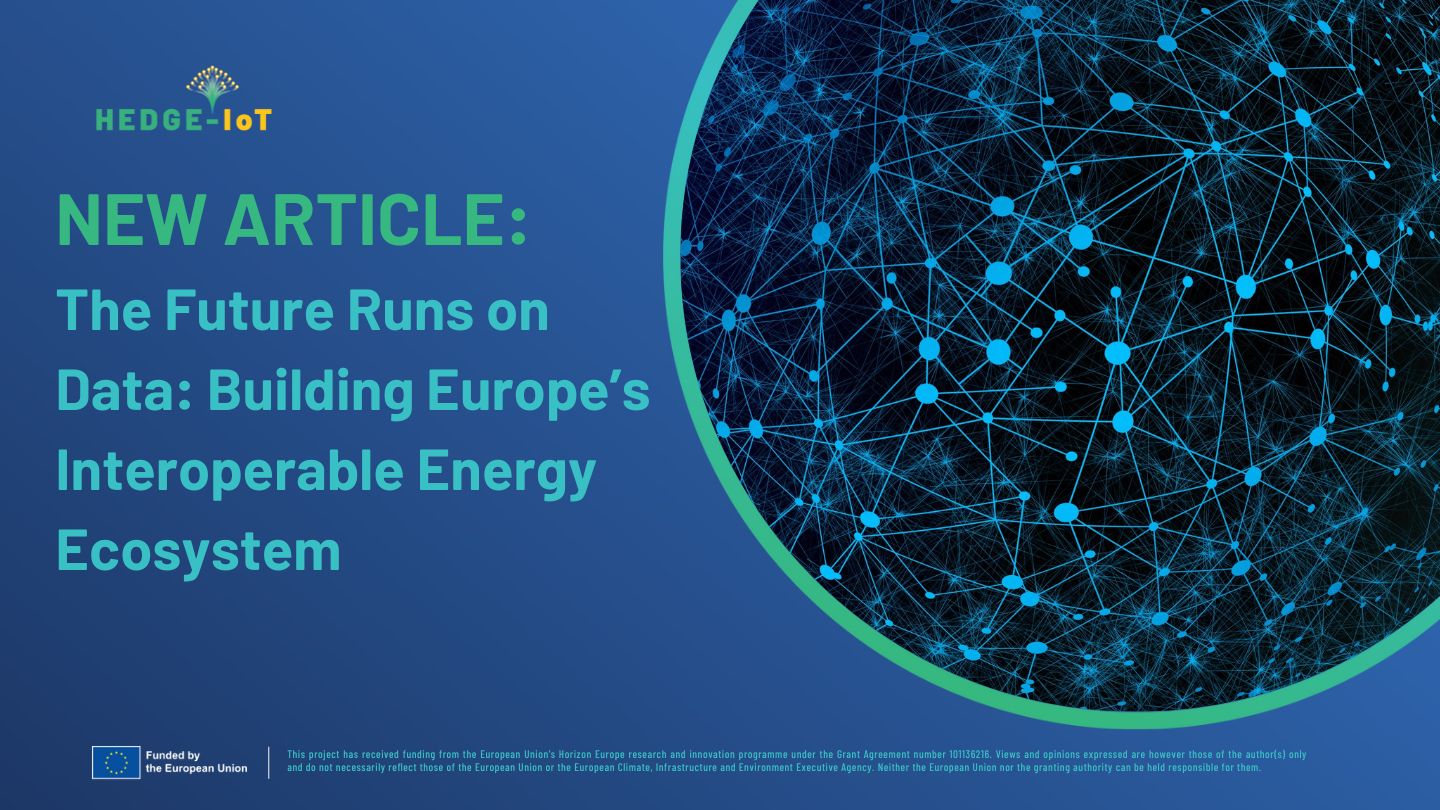
Europe envisages a future where local communities can generate, manage, and trade their own energy. In this direction, great emphasis is placed on the digitalization of infrastructure, supporting the EU’s main focus on shifting to renewable energy sources. Central to this evolution is achieving interoperable communication among the involved systems.
The newly introduced concept of energy data spaces aims to deliver secure, interoperable environments that allow stakeholders to exchange, govern, and use energy-related data across systems and borders. The recently published paper by the International Data Spaces Association (IDSA), titled Interoperability Framework in Energy Data Spaces, outlines the technical, semantic, organizational, and legal dimensions necessary to unlock seamless and trusted data exchange within the energy ecosystem.
To this end, several Horizon EU projects (e.g., Hedge-IoT) focus on applying the concepts of data spaces, providing invaluable feedback on their implementation and overall rollout.
Why Should We Care About Interoperability?
Interoperability is the foundation of the digital energy future. In today’s energy world, there is an increasing number of different actors — spanning from traditional utilities to regulators, startups, and citizens — while energy markets are becoming more decentralized and complex. Hence, the ability to share data across diverse actors gains high importance, as standardized, interoperable data exchange enables efficiency, transparency, and innovation.
The current picture of energy information exchange, however, includes fragmented, unused data often residing in various silos across the EU, rendering communication a high-cost and complex process. Interoperability is about fixing that. It’s about making sure that data — whether from a smart meter, a grid operator, or a local energy community — can be exchanged, understood, and used across platforms, safely and fairly.
And this isn’t just a technical issue — it’s about enabling transparency, reducing waste, and giving people more control over their energy future.
A Framework Built for the Real World
The IDSA’s Interoperability Framework in Energy Data Spaces is a practical blueprint that builds on the collaborative input of multiple EU-funded initiatives such as int:net, omega-x, EDDIE, Enershare, SYNERGIES, and DATA CELLAR.
Four dimensions of interoperability are identified:
- Technical – ensuring that IT systems can connect and exchange data securely.
- Semantic – enabling shared understanding of data formats and meanings.
- Organisational – aligning processes and responsibilities across stakeholders.
- Legal – complying with data protection, competition, and energy market regulations.
This multi-layered approach reflects the real-world complexity of the energy sector when trying to build a common data space in a regulated, fragmented landscape like energy.
The Power of Standards
To achieve interoperability, open standards play a crucial role. Key enablers like the IDSA Rulebook, FIWARE’s open APIs, and the Gaia-X Trust Framework lay the foundations for ensuring systems can work together securely and reliably.
In the energy domain, further guidance comes from organizations like ENTSO-E, which has developed domain-specific standards that define key data models and protocols. A fully interoperable data ecosystem must be federated, allowing different data spaces to function independently yet communicate through common interfaces and protocols.
This approach enhances scalability and inclusion — especially important for smaller actors like municipalities and local cooperatives.
Benefits for Local Energy Communities
One of the most exciting dimensions of interoperable energy data spaces is their potential to empower Local Energy Communities (LECs). These communities — comprised of residents, businesses, and public entities — can use shared data platforms to optimize local energy data exchange, improve self-consumption, and overall raise engagement in energy markets.
Through a data sovereignty methodology, along with real-time insights, LECs can coordinate energy usage, forecast production, and even apply peer-to-peer trading models. Interoperable communication ensures these actions are scalable and secure, and that local energy communities are enabled to interface with national markets and grid operators, overcoming technical or regulatory barriers.
Addressing Remaining Challenges
Despite significant progress, obstacles to full interoperability remain. The lack of alignment across data models, ontologies, and governance frameworks introduces friction and complexity, particularly when transitioning to broader regions or integrating legacy systems that still constitute a huge portion of the existing appliances in the European building stock.
IDSA emphasizes the need for a common language for energy data — not only in technical terms, but also in how stakeholders understand and interact with data. Federation services are key to bridging gaps, offering integration mechanisms that preserve autonomy while enabling interoperability across different use cases and domains.
Tailoring these frameworks to different market actors — from large DSOs to small cooperatives — is essential for embedding flexibility, adaptability, and clarity into the design of the energy data space.
Interoperability is no longer a nice-to-have — it is a cornerstone of the digital energy transition. As Europe builds its Common Energy Data Space, initiatives and frameworks developed by IDSA and its partners are paving the way for a more connected, inclusive, and efficient energy ecosystem.
By enabling communication among diverse energy systems, platforms, and actors — in a technically, semantically, organisationally, and legally sound manner — the groundwork is set for energy communities to flourish, market actors to collaborate, and innovation to thrive.
The future of energy is digital. But to make it work, data has to move — securely, meaningfully, and fairly. As we continue toward a smarter, cleaner energy future, the focus shifts to the invisible threads — the standards, frameworks, and agreements that hold it all together.
References
- IDSA Position Paper: Interoperability Framework in Energy Data Spaces (https://internationaldataspaces.org/wp-content/uploads/dlm_uploads/IDSA-Position-paper-Energy-interoperability-framework-v0.9-1.pdf)
- European Commission: Blueprint for CEEDS (https://enershare.eu/wp-content/uploads/Blueprint_CEEDS_v2.pdf)
- ENTSO-E: Common Grid Model Exchange Standards (https://www.entsoe.eu/data/cim/cim-for-grid-models-exchange/)
- FIWARE & Gaia-X Interoperability Materials (https://www.fiware.org/wp-content/uploads/FF_PositionPaper_FIWARE4DataSpaces.pdf)